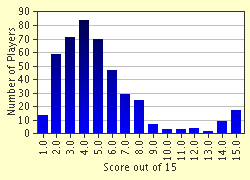Quiz Answer Key and Fun Facts
1. According to Plato, who became king of Lydia by using a magic ring that rendered him invisible?
2. Which of the following personages was famous for (among other things) possessing a ring set with a seal which purportedly gave him the power to control demons?
3. What trickster hero of the medieval “Beast Epics” claimed, falsely, to possess a magic ring?
4. A number of the tales included in the Thousand Nights and a Night describe magical rings which permit their wearer to summon genies or grant their wearer’s wishes. Which of the following is NOT a tale of the Arabian Nights involving such a magic ring?
5. According to the Heldenbuch (the “Hero-Book”), from whom did the Germanic hero Dietrich von Bern plunder a magic ring and belt which gave their wearer the strength of twenty-four warriors?
6. As related in the Morte d’Arthur (among other sources), what knight of King Arthur’s court had the use of a magic ring that changed the appearance of things and protected its wearer from loss of blood?
7. As related in the Mabinogion, what knight of King Arthur’s court possessed, for a time, a magic ring of invisibility?
8. In Ariosto’s “Orlando Furioso” (the premiere source for the Romances of Charlemagne and his court), the female knight Bradamante uses a magical ring to rescue her lover, the knight Rogero. One of the powers of the ring is to render its bearer invisible -- but only when held inside the bearer’s mouth. What other power of the ring is crucial to effecting Rogero’s deliverance?
9. According to one set of versions of the birth of Finn Mac Cumhail in Irish legend, a giant with a magic ring attempts to kill the young Finn. What is the power of the giant’s ring?
10. What prototypic accursed ring of power is the subject of the Saga of the Volsungs, not to mention Wagner’s “Der Ring des Nibelungen” cycle?
11. What was the special power of Draupnir, Odin’s dwarf-forged ring?
12. A number of the Household Tales collected by Jacob and Wilhelm Grimm include magical rings of one kind or another. Which of the following is NOT a correct matching of tale and ring?
13. In Tolkien’s “Lord of the Rings,” which of the following Great Rings did Gandalf wear?
14. In Tolkien’s “Lord of the Rings,” who forged the Seven and the Nine Great Rings under Sauron’s tutelage?
15. Alan Scott used a ring of power to fight injustice as which of the following superheroes?
Source: Author
xaosdog
This quiz was reviewed by FunTrivia editor
bullymom before going online.
Any errors found in FunTrivia content are routinely corrected through our feedback system.

